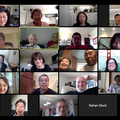Two curators + three sections + over 110 artists + more than 300 art pieces. Combining these many and varied parts into a single museum exhibition, Kokeshi: From Folk Art to Art Toy, was the task of Maria Kwong, who curated the show on behalf of the Los Angeles Toy, Doll & Amusements Museum (LATDA) and the Japanese American National Museum (JANM).
Kwong, who is affiliated with both institutions, had researched the kokeshi (a traditional Japanese wooden doll form) in connection with an earlier LATDA vinyl toy show but the combination didn’t work. She continued to notice the kokeshi doll icon in works of a number of contemporary artists.
“The human figure in its most basic form, a head and a body, opening it to individual artistic expression,” Kwong commented. But why did these artists select this iconic Japanese image? Kwong began exploring this enigma.
For example, Kwong had heard of James Watt’s use of kokeshi but knew nothing about him. She sent a friend to one of his shows in San Diego who discovered he’s of mixed ethnic descent. Kwong met with him and found that his kokeshi works began as an homage to his mother, who is from Yokohama, and that the kokeshi image is an expression of his Japanese heritage.
Kwong became familiar with other artists such as Alexandra Gjurasic and Chris Conway. Gjurasic is not of Japanese heritage but her mother lived in Japan as a child, and Gjurasic grew up with playing with Japanese toys. Chris Conway also is not of Japanese descent but her father was stationed in Japan and inspired her interest in Japanese culture.
When the Japanese American National Museum approached LATDA about curating an exhibition, Kwong thought of kokeshi. It would simultaneously fulfill LATDA’s desire to explore the connection between toys and culture, and would add an interesting artistic context to JANM’s core historical exhibition, Common Ground: The Heart of Community, located in an adjacent gallery.
Kwong’s vision was to juxtapose very traditional kokeshi along with very contemporary kokeshi art. Her goal as a curator was to provide historical context for this contemporary art form and show how kokeshi originated as a souvenir toy that went from East to West and evolved through cultural influence into a unique, American collectible art. She was compelled to include traditional kokeshi to show not just its origin and history but the workmanship involved. And to show that they’re handcrafted and hand-painted, with true traditional kokeshi revealed as being closer in spirit to the custom and contemporary art pieces than to the mass-produced souvenirs that are more widely known.
During exhibition’s development, colleagues at clothing and toy company Spicy Brown told Kwong about a 2007 kokeshi show in San Diego. The show’s curator was Conway. Like Kwong, it was vinyl toys that sparked her idea for the show. Conway felt there should be a greater diversity of artists involved with custom toys and that the kokeshi was the perfect object to customize. Conway had planned a series of custom kokeshi shows. All artists in each show would customize the same kokeshi form and each show would use a different form.
Kwong saw Conway’s custom show as a distinctive spin on and an added dimension to the contemporary show she was developing. Because it was a natural extension of what she was doing, Kwong invited Conway to make the next custom show a component of the larger kokeshi exhibition. Conway invited her favorite artists to participate, including some who’d never used the kokeshi form before. She received overwhelmingly positive responses from more than 100 artists, and the custom-kokeshi section of the show was on its way.
Putting on an exhibit of this scale has to have at least a few surprises. Kokeshi was no exception, but they turned out to be positive surprises. First, the Museum decided to allot a larger gallery space. This not only allowed for more works to be shown but turned out to be a fortuitous change as some of the items were larger than expected. James Watt’s kokeshifamily was life-sized. Also, Anthony and Itske Stern, whose collection comprised the traditional section, sent some pieces larger than anticipated. It was kismet to Kwong. “The bigger pieces were great considering the larger space.”
Another unexpected event was a custom piece by an overseas artist. The package had been opened by customs and the piece arrived with a hole bored in the bottom that hollowed out the kokeshi. Apparently the government searched it for contraband. Luckily, the exterior was undamaged and it was put on display.
Now that the exhibition’s been up for a while, what are Kwong’s hopes as curator? She wants visitors to have what Oprah calls the “a-ha moment.” For those who come to see just one part of the show—the traditional folk art or the contemporary—Kwong hopes that by seeing the two together that they’ll come away thinking about kokeshi differently.
“Visitors will gain an appreciation of something old or something new or reach a deeper appreciation of kokeshi,” says Kwong. “Listening to people going through the traditional part, they’ll say ‘Mom has kokeshi. Hmm, where are they?’ I have visions of kokeshi being rediscovered, appreciated and freed from storage. They’ll see the light of days once again because of the show.”
Kokeshi: from Folk Art to Art Toy is at the Japanese American National Museum through October 4, 2009.
© 2009 Japanese American National Museum






